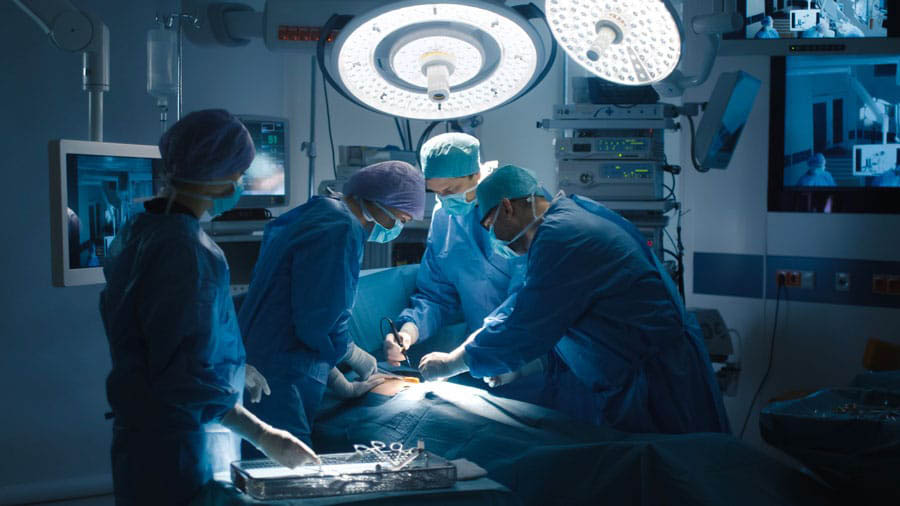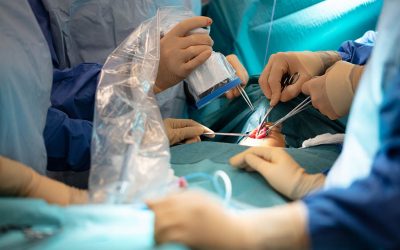Thyroid cancer treatment is primarily surgical. It consists of removing the thyroid gland, in whole or in part, to eliminate the tumor and prevent its spread. This operation is called a thyroidectomy. In this article, learn about the details of the procedure, possible complications and postoperative recommendations for patients with thyroid cancer.
What does thyroid cancer surgery involve?
The preoperative consultation
Following a diagnosis of thyroid cancer and depending on its evolution, an operation is usually scheduled. Before the operation, a preoperative consultation is organized with the surgeon and the anesthesiologist. They explain what will happen during the procedure and determine if additional tests are required beforehand (such as blood calcium levels).
The surgical procedure
During the operation, the surgeon makes a horizontal incision at the base of the neck in order to access the thyroid gland. If the tumor is malignant and larger than 1 centimeter in diameter, a total removal of the thyroid gland is performed. If the tumor is smaller, the removal may be partial.
The surgery is performed under general anesthesia with intubation. It usually lasts 1 to 2 hours. There is no significant blood loss.
In the case of papillary thyroid cancer, the operating team may perform a lymph node removal at the same time as the thyroidectomy. This procedure consists of removing the nodes around the thyroid gland.
The patient is usually hospitalized 1 to 3 days in total.
What are the risks of complications?
Thyroid surgery in patients with thyroid cancer is common. However, as with any surgery, there are risks such as infection or bleeding. But there are also specific risks, such as damage to the recurrent nerve and the parathyroid glands.
The recurrent nerve controls movement of the larynx and the vocal cords. The operation can sometimes lead to its paralysis, which results in a weak, hoarse or broken voice sometimes over several weeks. If these disorders persist, speech therapy may be required.
The parathyroid glands are four very small glands that regulate calcium levels. Accidental damage to these glands can lead to a disturbance in their function, which will need to be compensated for by taking calcium and vitamin D analogues for several weeks, months or for life in some cases.
How to minimize risks?
Provision of care by a specialized center and the surgeon’s experience are determinant factors. There are also innovative technologies such as FLUOBEAM® LX that help surgeons operate with greater precision and confidence. This solution is currently used in the United States and throughout the world.
FLUOBEAM® LX facilitates parathyroid glands localization and preservation through autofluorescence to prevent accidental injury. It is an aid for the surgeon, offering better visualization and enabling a more accurate gesture.
Prof. Frédéric Triponez, Head of the Department of Thoracic and Endocrine Surgery at the University Hospitals of Geneva in Switzerland, explains: “With regards to parathyroids, until the arrival of autofluorescence and fluorescence with angiography […], we could not really localize, we used the eye only, we had no guarantee that the parathyroid glands were functioning properly”.
FLUOBEAM® LX is therefore an effective solution to help detect and preserve the parathyroid glands.
What happens after thyroid cancer surgery?
Postoperative follow-up
A postoperative consultation with the surgeon is scheduled to assess healing and recovery. The patient often receives a sick leave. Its duration depends on the patient’s professional situation and general health. It usually varies between 10 and 21 days.
Sport and leisure activities can only be resumed after complete healing. In addition, full recovery of neck mobility is required before driving again.
If it has been confirmed that the nodule is cancerous, additional treatment may be prescribed, in particular if the recurrence risk is considered high, with the administration of iodine 131. Radioactive iodine treatment aims to eliminate any remaining cancerous cells after the operation. The radioactive nature of this treatment requires hospitalization in a specialized unit.
Treatment and recovery assessment
After surgery, to compensate for the absence of thyroid (and sometimes in the case of partial removal), it is necessary to take synthetic thyroid hormones. This treatment, called thyroxine, comes in the form of a tablet to be taken once a day upon hospital discharge. It is important to find the right dosage that ensures a good hormonal balance (measured by the level of TSH or thyroid stimulating hormone). Once the right dosage has been found, a blood test is only required once a year to monitor the treatment.
A check-up is usually performed 9 to 12 months after surgery. It allows to confirm that there is no recurrence of thyroid cancer. If no abnormalities are detected during the various tests performed, the risk of subsequent recurrence is very low.
Also read: How is Thyroid Cancer Treated?
Thyroid cancer surgery thus consists of total or partial removal of the thyroid gland. Thanks to the advances in medicine and medical imaging, the surgical treatment risks are minimal and patients can maintain a good quality of life. The cure rate for thyroid cancer exceeds 90%.




